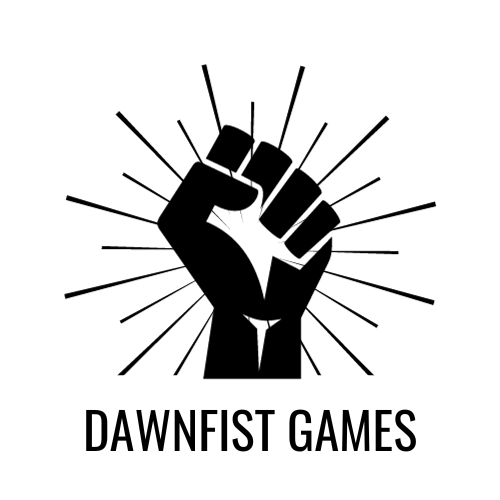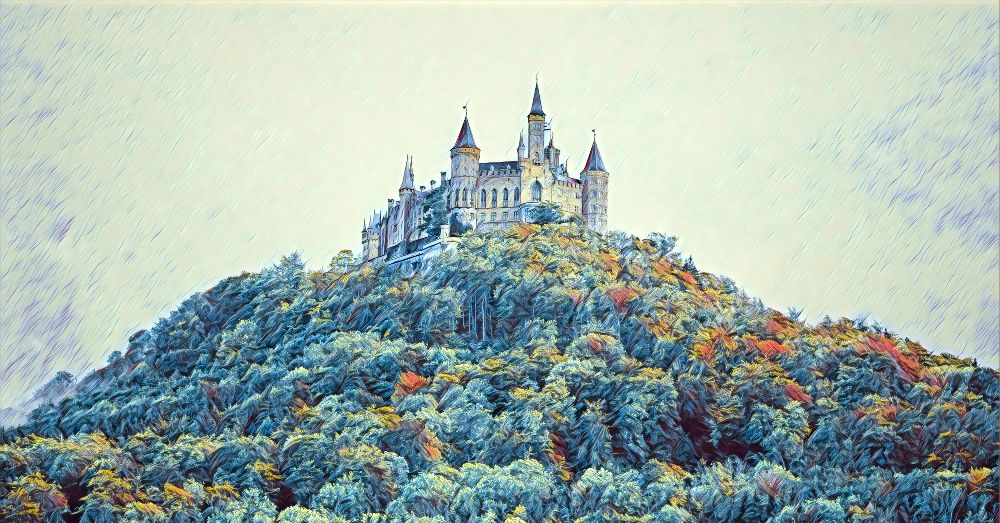Connecting the dots…
There are many ways of running campaigns and scenarios, one of them is the pointcrawl. It’s not so much a campaign structure, but more a way of abstracting maps and traversal. You could run a sandbox campaign as a pointcrawl, but you can also run an adventure path campaign as a pointcrawl. Pointcrawls are also great for one-shots, so yeah, even if people sometimes talk about pointcrawl campaigns, that’s not really what points crawls are.
In this guide I’ll take you through what pointcrawls are, how to best prep for a pointcrawl based scenario/campaign and some tips and trix when running one.
What is a pointcrawl?
The best example of a pointcrawl is a subway system map. It consists of points (stations) connected by lines (the train tracks), and to reach certain points on the map you need to go a specific route via a hub and sometimes change lines. Pointcrawls are intended to work exactly the same way.
Let’s take a look at the yellow and purple line at the upper center of the map below. You can’t get to Finch from Don Mills without passing through Sheppard-Yonge. That logic and organization is what pointcrawls are all about. But we can add another layer to it, that makes it come together even better, both in real life and in the game fiction.
In the real world you could probably take a buss straight from Don Mills to Finch, but that would be a connection that is hidden from the player characters. But as they learn of the world, and make their way around it, they will discover alternate routes, shortcuts and new exciting locations!
In this example Leslie could be the Black Woods, filled with goblins and giant spiders. Bassarion would be the broken bridge across the raging river and Bayview the Hunters Cabin. Now there might also be (not marked on the map) the secret Crystaline Tunnels, placed northwest of Don Mills, which connect Finch and Don Mills. It’s a hidden location but once the PC learn of it, and make their way through the Crystaline Tunnels, they will have discovered a shortcut between the two locations, which acts as the buss in the real world example above.
A great example of a simple pointcrawl is our adventure module, The Crimson Monastery, perfect for a short mini campaign or just 3-5 sessions stringed together.
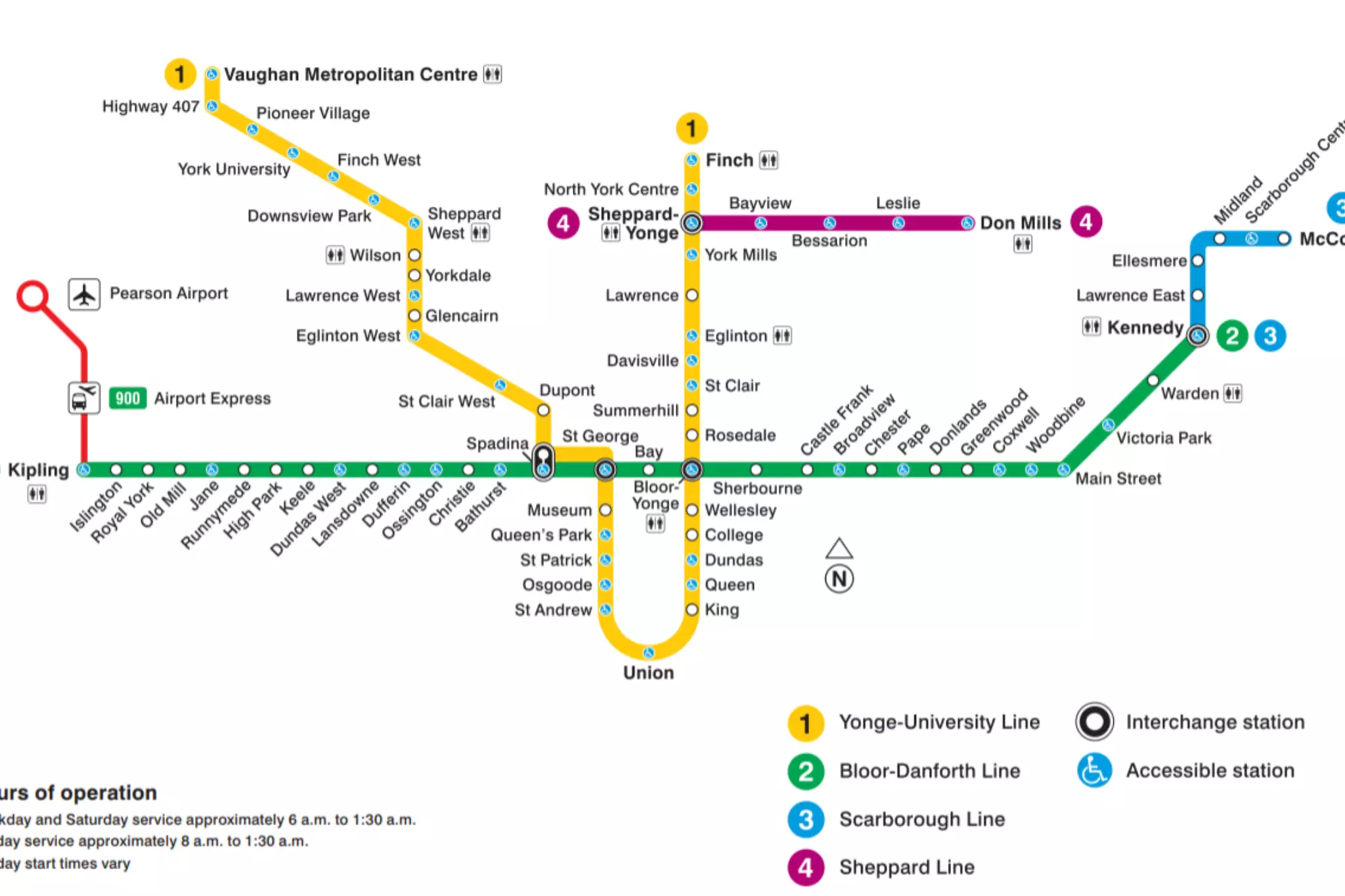 Three types of points
Three types of points
A fundamental concept in pointcrawls is that there are three types of points on the map:
- Known: The locations that everyone in the region, including the PCs, know of beforehand. A great example is how the player can see Beregost, Nashkel, Friendly Arm Inn and Baldurs Gate on the map in Baldurs Gate 1 right from the start, without any exploration. These points are usually settlements and landmarks, well known to everyone in the region.
- Unknown: The majority of all locations fall in the “Unknown” category. The places that the PCs will come across as they traverse the map. If the Cinderleaf Forest is located between two settlements, the PCs will encounter it and end up in it when they attempt to travel from settlement A to settlement B. And if Frog Pond is located north of Cinderleaf Forest the PCs will learn of it’s location when in Cinderleaf Forest and asking the GM where they can travel to from here. Just think of it as a road you are driving along for the first time, as you drive you will come across various places automatically. They aren’t hidden, but you didn’t know they where there until you drove past them.
- Hidden: These locations require something extra to be able to travel to. In a dungeon pointcrawl it could be a successful investigation check to discover the button in the bookshelf, opening the secret door. On a region map pointcrawl the PCs might need to dare explore the glacier to find the Frozen Cave. Unlike Unknown locations, Hidden locations aren’t just handed to the PCs by visiting an adjacent point on the map.
Points shouldn’t be equal in size
An important difference between pointcrawls and hexcrawls is the size of the points/nodes on the map. In a hexcrawl, all hexes are the same size, that is the whole point of the system. But in pointcrawls the points can vary greatly in size. One point on the map could be the city of Baldurs Gate and another point can be a small broken bridge across a raging river. They both deserve a point on the map and to be a part of the “traversal ecosystem” of a pointcrawl.
This works perfectly well because pointcrawls are all about abstracting the distance and focusing on the potential events and locations the PCs pass by. In a hexcrawl the distance is critical, it’s a foundational pillar of the whole concept, and it allows the players to make strategic decisions.
The main difference from a hexcrawl
Compared to a hexcrawl, the flexible nature of the pointcrawl map makes it a lot easier for you as the GM when prepping the game. One example of this is the fact that you can be very loose with filling the space between two points of interest, sometimes you can have three points in the 20-mile stretch between two major hubs, and sometimes you could have just one point the 50-mile stretch between two hubs. In a hexcrawl all hexes are the same size, and you need to spend a lot of time filling the entire map with interesting and exciting things to encounter and discover, otherwise it’s just a waste of space.
Dungeon pointcrawls
The pointcrawl concept works equally well for both outdoor and indoor maps. In a dungeon pointcrawl each room is illustrated by a point on the map, and the connectors are the connecting hallways. As an example, let’s think about your apartment as a pointcrawl. To get from your bedroom to your kitchen you need to pass through the living room and then your hallway, which also connects to your kids room, that’s a pointcrawl. The exact length of your hallway isn’t important when the PCs explore the dungeon, it’s just there to connect the locations that are actually interesting. Unless, unless there is something important going on in the hallway, like a trap, and then it wouldn’t just be a line on the map connecting two points, it would be it’s own point, the “Trapped hallway”.
As you see, it’s not a complicated concept and it works just as well for indoor maps as region maps. Oh and let’s not forget secret rooms! Imagine that the entrance to your bathroom is from the hallway (making it an intersection connecting to four rooms, kids room, kitchen, living room and bathroom), but the bathroom door is secret. Now you’ve really leveraged the full potential of the pointcrawl, because the bathroom won’t be a valid point to choose from unless the PCs have discovered it, which they could do by investigaing and finding clues.
Below is an example of how I turned a piece of art (by the very talented Paths Peculiar) into a pointcrawl. To get to the boat house, (C) you need to pass through the kitchen (B), in which there is a secret entrance to the wine cellar (D), noted by a dashed line.
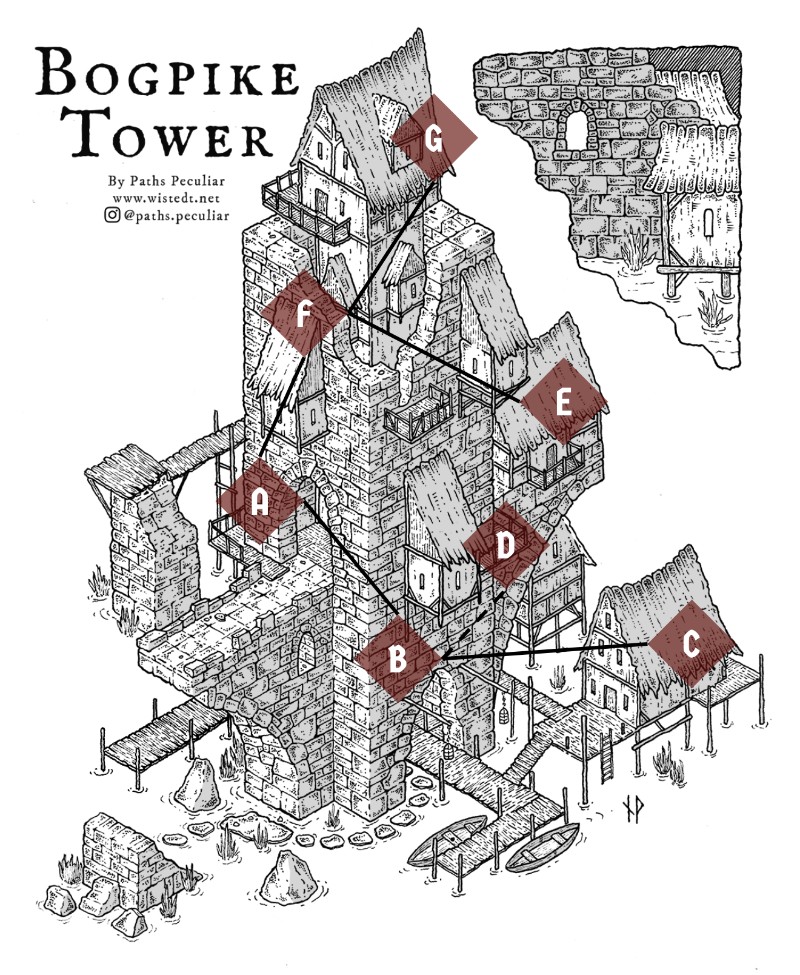
A simple example of a dungeon pointcrawl
You don’t need to draw complex dungeon maps, a pointcrawl can work just as well. It all depends on the level of visual detail YOU need to be able to run the place in a fun and engaging way. If text descriptions of the rooms work just as well for you, don’t waste your time drawing maps.
Region map pointcrawls
The most common use of pointcrawls are region maps. They work on a kingdom or continent level, but at that scale they might either become cluttered or just too sparse to feel immersive.
Below is the tutorial region of White Orchard from The Witcher 3, which I’ve turned into a simple pointcrawl. All the locations aren’t there, total conversion isn’t the point, the point is to show how it can be done.
Dashed lines lead to Hidden locations, the PCs would have to learn about the path/destination before they can traverse it. A great example, especially for us who have played this game, is the gryphon nest at C. If you start a campaign in this region the PCs wouldn’t know where the nest is, but they will hear rumors about how the gryphon is terrorizing the region around the village. With time they might spot clues, investigate tracks and so on, and eventually discover where the nest is, thus unlocking that point on the map.
The same goes for the bandit camp at J, in the northern part of the map. It’s hidden, but with investigation and exploration the PCs can find it, perhaps by questioning or charming one the bandits when he’s out drinking at the tavern in White Orchard (A). Once the learn of the location, they’ve unlocked a new point on the map.
There are definitely connections missing on the map below, a full conversion isn’t the point, illustrating how you could turn a familiar map into a pointcrawl is.
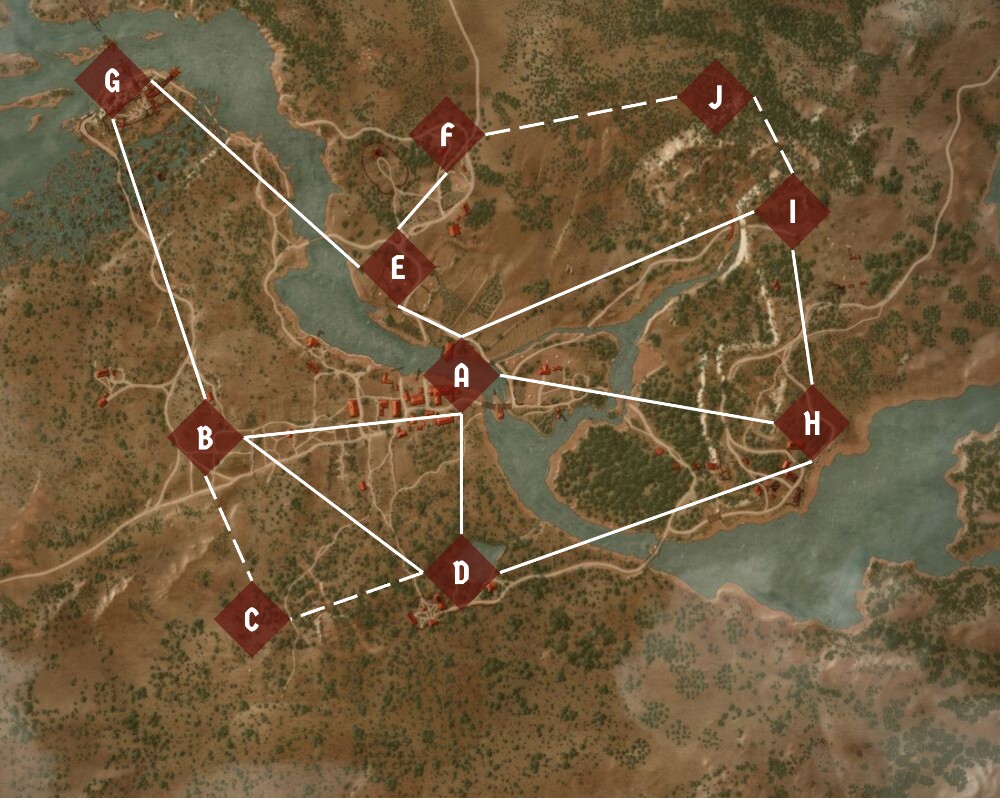
Turning White Orchard from The Witcher 3 into a pointcrawl. I’m aware that it’s not exhaustive, but that’s not the point (pun intended).
City map pointcrawls
The above subway map is a great example of how pointcrawls can be used to organize city maps and run city based adventures. The same logic applies as with dungeon and region maps, it’s all about using the terrain to connect points in a logical way.
In some smaller cities all points might be connected to each other, so you can basically go anywhere anytime, without following a set path. But in larger cities the available routes will be limited by rivers, canals, cliff sides and other terrain features. So looking at the subway map again, it’s clear that there is some sort of terrain hindering travel between the western and eastern parts of the yellow line, perhaps a river?
How to prepare a pointcrawl
A pointcrawl map can be used as the centerpiece of any kind of campaign, from a super railroaded adventure path campaign to a survival heavy sandbox campaign, and anything in between.
What you need to prepare in order to be able to run it can be boiled down to the following three things:
- The map and all locations
- Random encounters
- Details on how to discover the Hidden locations
You might also need to establish travel rules, if that is not already present in your game, but since a lot of games have that, I won’t include any recommendations or details on that topic.
1: The map and all locations
This will of course be the biggest task, and if you are planning a large scale campaign that will last 15+ sessions, you are looking at a truly monumental task. My personal recommendation is to write smaller campaigns in general, and never prepare more than necessary. Just focus on having material for the first two sessions, then you prep as you go and as the campaign develops, but I’ll cover that in a different guide.
First of all you need a map to place points on. You can draw one by hand, with a digital tool like Inkarnate or just pick one online, if you use it for your personal home game you can use whatever map you find without having to worry about accrediting or copyright stuff. If you plan on publishing your work you are better of drawing your own map.
Placing the points that the PCs will be able to visit on your map (towns, caves, villages, bridges, forests etc.) is a highly dynamic task, there is no right or wrong here. One thing that is generally true when it comes to ttrpg prep is that you don’t need as much content as you think.
If you are prepping your first pointcrawl I recommend creating a small region, enough for 3-6 sessions of play. A village, some interesting locations of varying size, a dungeon and maybe a smaller settlement. Make sure at least two or three Hidden locations, forcing the players to interact with the world to learn of these locations. The Crimson Monastery is a perfect example of such a pointcrawl module. You can easily drop it into any fantasy world and have content for a few sessions of play.
2: Random encounters
Random encounters are a staple in ttrpgs, and for good reason. So wether you are prepping a dungeon pointcrawl or a region map you’ll need random encounters.
To make random encounters actually add value to the game play, they need to be varied. Encounters shouldn’t all be combat focused, they should be a good mix of combat, hazards, setbacks, tough choices, boons and social encounters. Variety is critical, because If the random encounters don’t create unique and memorable moments, travel will feel like chore that just eats up valuable game time.
Let me explain the various encounter types:
- Combat – Straight up combat, whatever the PCs encounter wants them dead
- Hazards – Rockfalls and poisonous swaps that need to be traversed
- Setback – Lost supplies, broken wagon wheels, illness or lack of resources
- Tough choices – A bag in the middle of a raging river, something glimmering in a harpy nest or a strange light coming from a small cemetery. Should the investigate or move along?
- Boons – Straight up beneficial encounters, a patch of edible mushrooms, a hidden cache or an abandoned campsite with dry firewood
- Social encounters – NPCs that aren’t directly hostile, for best effect, make a reaction roll, sometimes it’s a new friend, others it’s something that wants to the PCs
There are millions of potential encounters, and you could probably argue that there are other types of encounters, but personally I feel that these five cover them all.
How to best structure random encounters in pointcrawls?
There are four ways of doing this, from most specific and qualitative to least.
- A: Unique encounters based on which two points the PCs are traveling between
- B: Encounters by sub-region
- C: Encounters by terrain type
- D: Generic encounters
The validity of these four options will, to a great extent, be dependent on the size of your map. In a small pointcrawl, like a dungeon or the area around a village, option “D: Generic encounters”, will work perfectly well. But if your map spans a larger region it will feel unimaginative and bland. Let’s look at the different options.
A: Unique encounters based on which two points the PCs are traveling between
This means preparing unique lists of random encounters based on which specific points the PCs are traveling between. On a region map this could mean that there are completely different encounters when traveling west from the village to the ravine as opposed to traveling east from the village to the lake. Even if all three areas are located in the “Whispering Vale”.
This option requires the most amount of prep and therefore is only really recommended for small region maps or small settlements with a handful of points.
Best suited for: Small region maps, small settlements.
B: Encounters by sub-region
Another way of doing it is by sub-region. As in, when traveling between any two points in the Northern parts of White Orchard, the PCs can encounter bandits, ghouls and the hunters. And when traveling between any two points in southern White Orchard they can encounter the gryphon, wights and wolves. Fairly straight forward, but still at least twice the prep work of option D.
This also works very well for city pointcrawls, where a sub-region would be a part of town, like the docks, the temple district and so on.
This is in my opinion the best option, because it’s fairly light in prep, but still offers a lot of interesting effects, and over time, the PCs will learn what creatures live in the various parts of the region.
The best way to both prepare for, and run encounters by sub-region, is to use the method outlined in our “Ultimate random encounter generator“, it’s by far the best method I’ve tried during my 20 years of being a GM.
Best suited for: All kind of region maps, all kind of settlements.
C: Encounters by terrain type
The third option is to have random encounter tables by terrain type, so different encounters for mountains vs forest vs coast. This works well if you have distinct terrain zones that are not repeated on the map, or are at least clustered close together. What I mean by this is having only one mountain range, or perhaps two mountain ranges but both of them are located in the northern part. If you have multiple mountain ranges spread out across a large region map, it won’t make much sense if the Red Hand orc tribe can be encountered in all of them, they most certainly live in one of the mountain ranges, not all of them.
Best suited for: Small region map.
D: Generic encounters
The last option is to just have one table of random encounters that are valid regardless of where the PCs are traveling on the map. This works fine if the map is very small, or in the case where you are building a dungeon map pointcrawl, here it’s often not worth it to have different random tables for various parts of the dungeon.
Best suited for: Dungeons and small settlements.
3: Details on how to discover Hidden locations
The third and last part of your prep is figuring out how the PCs will be able to discover the various hidden points. Remember that the Unknown points are often discovered simply by visiting an adjacent point on the map, but Hidden locations require something more, sometimes careful investigation, sometimes knowledge gained from NPCs or other sources of information.
Deciding on how to discover a hidden location in a dungeon pointcrawl could be as simple as placing a secret button or lever in an adjacent room, or just writing a bullet point in the room description on how there is a secret tunnel behind the tapestry next to the fireplace. If the PCs walk behind the tapestry they will find it.
On a region map it’s more complicated, because realistically, the PCs could travel in any direction they want, unless it’ blocked by a river of lava or something. So you need to both build in ways for the PCs to learn of the location of a hidden point of interest, either by speaking to the locals, studying books in the local library or finding hand drawn maps. But you also need to build some sort of exploration system for when the players can’t figure out how to learn of the location of the Lost Tomb and just decide to walk straight out into the wilderness and search the good old fashioned way.
Designing an exploration system, it can be as simple as “Roll 1D6 for every day spent searching the Cinderleaf Forest, on a 6 the PCs find the Lost Tomb”. This means there is a 16.67% chance of finding the place they are looking for, which is a fairly low chance, and for every day spent searching they need supplies, money to pay for their room at the inn and they also risk random encounters when searching the forest. The chances of finding the point of interest the PCs are looking for can also be tweaked, depending on the terrain and the size of the location. So when looking for the Temple of Flames in the mountains they might find it on a roll of 5 or 6 on a D6, because it’s much larger and their view isn’t obscured by trees.
There are hundreds of potential ways of resolving free exploration in a pointcrawl, I won’t list all of them. Feel free to use the one detailed above if you don’t feel like inventing your own.
How to run a pointcrawl
The only critical thing needed when running pointcrawls is that you have one player map and one GM map. The player map should only feature the Known locations, and of course information on the general terrain, so that the players can make informed decisions. But overall, running a pointcrawl isn’t any different than any other type of game. The pointcrawl map itself isn’t a style of campaign, it’s just a way to organize points of interest on a map to make it easily understandable and gameable. So just be clear with your players that they can decide where they want to go.
A handful of tips and tricks
- Each Hidden location should have multiple ways of discovery, don’t just place one clue hidden in an obscure location, because that clue will be missed. Place 2-3 clues or secrets for each Hidden location you want the PCs to be able to find.
- For region maps, make sure you’ve placed at least a handful of Known locations, so that the PCs have some sort of direction when they want to explore the map. This doesn’t apply to dungeon pointcrawls since the PCs explore those room by room.
- For region maps, Don’t overthink it! Whatever is located in the areas of the map where there are no points of interest is irrelevant. The whole idea of pointcrawls is to make it as easy as possible to populate gameable maps, as opposed to hexcrawls where you need a way to fill every single inch on the map with at least something.
- Use knowledge of Hidden locations as rewards. This can either be in the form of finding ancient scrolls in a treasure hoard, or information from an NPC as a thanks for helping them.
- As with all exploration focused campaigns, a robust random encounter system will elevate your game more than you can imagine. Make sure you’ve got random tables for encounter types, activity, distance from the PCs and reactions. This will create truly random encounters and lead to some really cool situations neither you nor your players would have expected.
Resources for prepping a pointcrawl
If you need inspiration or concrete resources to help you plan and prep your pointcrawl, check out some of our best stuff below:
- NPC generator
- Adventure generator
- The 14 challenges in TTRPGs
- Why hasn’t the dungeon been plundered yet?
Closing thoughts on running pointcrawls
I hope this guide to prepping and running pointcrawls has helped you understand the concept and that you now feel like you can create your own. I personally love pointcrawls since they are so easy to create and fun to run.
I think the best part of pointcrawls is that they are designed to make both the prep and running them as gameable as possible. Placing points of interest and figuring out how they should be connected is a fun mini game in itself. And plotting out hidden locations and coming up with creating ways to discover them is both fun and it makes it easy for me to known when I’m done with my prep. When building a hexcrawl or a more abstract type of map I never get that feeling of being done, but the way pointcrawls are designed, you usually get to a point (pun intended) where it all just comes together in sort of mathematical way, it all clicks and you feel done, which is a great feeling!
If you liked this guide and found it valuable, then don’t miss our detailed breakdown of “The 14 challenges in TTRPGs” and “How to improvise as a GM“, and spend a few minutes to check out our game system, Adventurous, that makes running pointcrawls super simple!
